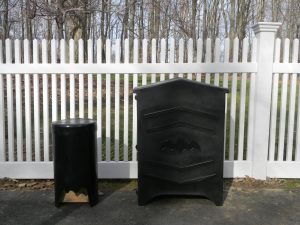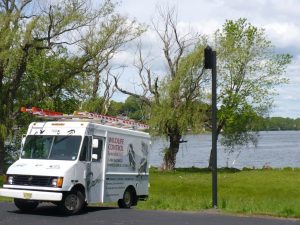Bat Facts:
- Bats account for approximately 25% of the world’s mammal population, and are the only true flying mammal.
- Bats are extremely vital to the environment. They pollinate flowers anddisperse fruit seeds. In addition they are economically important, as they consume insect pests, reducing the need for pesticides.
- For such a small mammal, bats live long lives, and individual bats can live to be 30 years old. Female bats give birth to their 1st off spring at approximately 12 months old
- Female bats typically only have 1 pup per year and occasionally deliver 2.
- Female bats born in a structure “Imprint” on that structure and return to the place they were born to give birth to their off spring. These locations are referred to as “Maternity Colonies”, and these colonies can be present at the same location for over 100 years.
- Bats are capable of catching hundreds of insects in an hour.
- Nursing mother bats can eat the equivalent of their body weight per night.
- Bats have been known to travel as far as 3 miles away from their roost as they forage for food.
- New Jersey supports 6 year-round resident bat species.
- The Big Brown bat and Little Brown bat are the ones that are most likely to come in contact with humans. Both species prefer to roost in manmade structures during the summer, and big brown bats have been known to hibernate in buildings as well.
- The other 4 year round residents are the eastern small-footed bat, The tri-colored bat, the northern long-eared bat, and the federally endangered Indiana bat
- New Jersey also has 3 part-time resident bats including the hoary bat, the eastern red bat, and the silver-haired bat all of which migrate south for the winter
- It is essential for bats to remain undisturbed when they hibernate during the winter.
- The bats that inhabit New Jersey may look big, but they are actually rather tiny with Little Brown bats weighing in at between 2–0.5 ounces and Big Brown Bats weighing in at between 0.5 and 0.65 ounces.
- With very little body fat and the absence of food during the winter, if they are disturbed, there is a high likelihood that they will not survive the winter.
Bats & the Law
- Bats are protected under both State & Federal Law
- It is illegal for anyone, including animal control officers and exterminators, to kill bats.
- The following provides information regarding time frames associated with excluding bats
- May 1st – July 31st
- Nursery colonies are active: bats and their flightless pups may be present in the roost.
- ONLY limited bat-proofing permitted. All unused cracks and openings in the house may be sealed while still allowing bats to enter the building. Seal potential points of entry into the living quarters (most important step). Seal all unused cracks and holes on the outside of the building. There are probably many of them because bats can enter a building through a tiny crack or hole smaller than a nickel. Do NOT seal the primary entry/exit hole(s), and don’t separate the mothers from their pups. Females must be able to enter and exit the building freely. If females are sealed out from their pups they will actively search for a new entrance and may end up in the living quarters.
- April 1st – April 30th
- Bats may be present in the roost but pups are not yet born. Bat-proofing with use of one-way doors.
- One-way doors enable the bats to leave on their own, but they won’t be able to get back inside. All other cracks and holes on the outside of the structure should be sealed prior to installing one-way doors as bats will try to get inside the building using another hole or crack.
- August 1st – October 15th
- Bats may be present in the roost but all young bats should be flying. Bat-proofing with use of one-way doors.
- One-way doors enable the bats to leave on their own, but they won’t be able to get back inside. All other cracks and holes on the outside of the structure should be sealed prior to installing one-way doors as bats will try to get inside the building using another hole or crack.
- October 16th – March 31st
- Little brown bats have returned to caves and mines for the winter. Big Brown bats may remain.
- Complete bat-proofing. Little Brown bats are hibernating in caves and mines. Caution should be taken to make sure that big brown bats are not hibernating in the residence (usually in the attic or basement) before bat-proofing the building. During this time, all potential openings can be sealed using caulking, foam insulation, wood, or other materials that will close any opening greater than ½ inch in size.
- The IMPORTANCE of Hiring a Professional Expert when it comes to Excluding Bats and Bat Proofing Your Home.
- Bat Proofing a home is never an “anticipated expense, and often expensive. For this reason it is important that you do your homework prior to hiring someone to perform the Exclusion/Bat Proofing Process.
- Pest and Exterminating Companies often offer this service because it is lucrative. However, their core competency which revolves around mice and bugs involves using snap traps, glue traps and chemicals to keep the problem under control. That’s why they offer ongoing maintenance contracts. Their expertise isn’t in sealing up gaps on the upper levels of the outside of your home.
- Whoever you select make sure you understand:
- The materials they will be using to seal the gaps and opening. Things like expansion foam and wire mesh often result in an end product which distracts from the aesthetic look of your home.
- Understand the warrantee/guarantee
- Most people who have bat issues have had them for a long period before they realized the problem. Bats a small, nocturnal and seldom seen. For this reason, you want a warrantee/guarantee period of at least 18 months. This timeframe will allow you to observe over a period of 2 summer seasons to insure the bats issue has been eliminated.
- Bat Proofing a home is never an “anticipated expense, and often expensive. For this reason it is important that you do your homework prior to hiring someone to perform the Exclusion/Bat Proofing Process.
- Little brown bats have returned to caves and mines for the winter. Big Brown bats may remain.
- Bats may be present in the roost but all young bats should be flying. Bat-proofing with use of one-way doors.
- Bats may be present in the roost but pups are not yet born. Bat-proofing with use of one-way doors.
- Nursery colonies are active: bats and their flightless pups may be present in the roost.
- May 1st – July 31st
Bat Houses
- Our clients often ask us about installing bat houses. Dependent upon the property, when the appropriate conditions apply (orientation to the sun, ample protection from predators, etc.) we offer our clients who use us to bat proof their home the option of installing a bat house.
- We purchase the Bat Can and Bat Bunker bat houses we offer from Bat conservation Management http://www.batmanagement.com/Ordering/ordermain2.html

Bat Can & Bat Bunker

Installation of a Bat Bunker we installed following a bat exclusion project we did for a client.

Bat Can installed on a client’s water front property
For wildlife control or pest related problems in New Jersey, please call us: 1-888-SKUNKS2
1-888-758-6572
